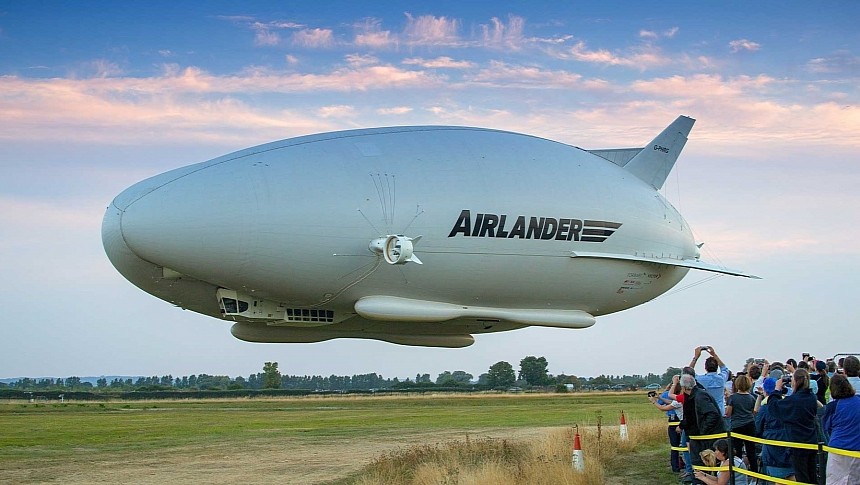If there were any doubts left about the Airlander’s glorious return, this new partnership between BAE Systems and its manufacturer would shatter them. An intriguing plot twist is taking this famous concept with a funny nickname from a luxurious air travel alternative for the wealthy to a high-power, high-capacity flying machine for military applications.
It’s hard to picture this funny-looking airship as a military aircraft on the prowl, yet this is what’s in store for it. BAE Systems, a world leader in army technology, sees great potential in this large aircraft designed to operate sustainably.
HAV (Hybrid Air Vehicles) agreed to collaborate with BAE Systems on the potential defense applications for the Airlander 10. The two will initially look at three potential uses – ISR (Intelligence, Surveillance, and Reconnaissance) operations, logistics, and the deployment and recovery of UAS (unmanned aerial systems).
What are the qualities that make Airlander 10 suitable for such demanding defense tasks? First, there’s the incredible autonomy – this gentle giant can stay in the air for up to five days. Then, there’s the massive capacity. With a payload of more than 10 tons, it can carry an impressive array of systems onboard (from computing and communication to those that are ISR-specific).
The Airlander also pairs its autonomy with extreme deployability. Despite its mammoth-like dimensions, this thing is surprisingly flexible when it comes to infrastructure. It can basically operate from any flat surface, including water. This hybrid capability makes it excellent for maritime and coastal operations, in addition to ground-based ones.
The military-configured Airlander would be able to carry more than current cargo helicopters, while operating at lower costs and with greater performance. It could transport a huge payload over 2,000 nautical miles (3,700 km).
Sustainability is another major asset for the military. HAV designed this airship precisely as a sustainable alternative to current large aircraft. The low fuel consumption will enable Airlander 10 to cut CO2 emissions by 75%. Over time, HAV wants to take this even further and switch to an all-electric configuration that will lead to zero emissions.
All of these qualities determined BAE Systems to see Airlander as the right choice for future defense fleets. Things are changing, including the stringent need for sustainable alternatives. HAV believes its flagship product to be the world’s most efficient large aircraft, which could also mean unprecedented capabilities for defense.
This exciting project will be coordinated by FalconWorks, which is BAE Systems’ new center for advanced and agile research and technology development in the Air sector.
In the meantime, HAV is working on opening a production facility in South Yorkshire, in collaboration with local authorities. The plan is to reach a 12-unit per year capacity. Air Nostrum Group, HAV’s main commercial customer, is set to start operating the Airlander 10 by 2027.
HAV (Hybrid Air Vehicles) agreed to collaborate with BAE Systems on the potential defense applications for the Airlander 10. The two will initially look at three potential uses – ISR (Intelligence, Surveillance, and Reconnaissance) operations, logistics, and the deployment and recovery of UAS (unmanned aerial systems).
What are the qualities that make Airlander 10 suitable for such demanding defense tasks? First, there’s the incredible autonomy – this gentle giant can stay in the air for up to five days. Then, there’s the massive capacity. With a payload of more than 10 tons, it can carry an impressive array of systems onboard (from computing and communication to those that are ISR-specific).
The Airlander also pairs its autonomy with extreme deployability. Despite its mammoth-like dimensions, this thing is surprisingly flexible when it comes to infrastructure. It can basically operate from any flat surface, including water. This hybrid capability makes it excellent for maritime and coastal operations, in addition to ground-based ones.
The military-configured Airlander would be able to carry more than current cargo helicopters, while operating at lower costs and with greater performance. It could transport a huge payload over 2,000 nautical miles (3,700 km).
Sustainability is another major asset for the military. HAV designed this airship precisely as a sustainable alternative to current large aircraft. The low fuel consumption will enable Airlander 10 to cut CO2 emissions by 75%. Over time, HAV wants to take this even further and switch to an all-electric configuration that will lead to zero emissions.
All of these qualities determined BAE Systems to see Airlander as the right choice for future defense fleets. Things are changing, including the stringent need for sustainable alternatives. HAV believes its flagship product to be the world’s most efficient large aircraft, which could also mean unprecedented capabilities for defense.
This exciting project will be coordinated by FalconWorks, which is BAE Systems’ new center for advanced and agile research and technology development in the Air sector.
In the meantime, HAV is working on opening a production facility in South Yorkshire, in collaboration with local authorities. The plan is to reach a 12-unit per year capacity. Air Nostrum Group, HAV’s main commercial customer, is set to start operating the Airlander 10 by 2027.








